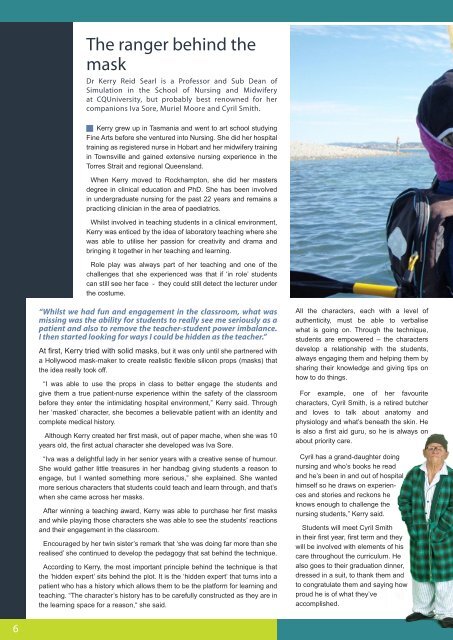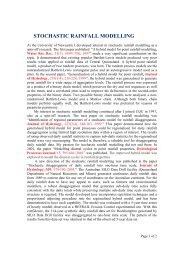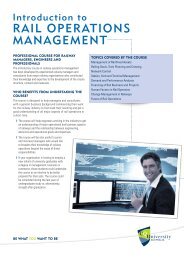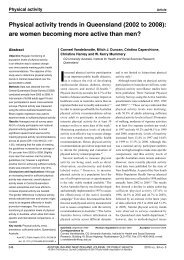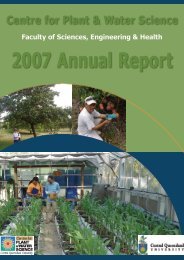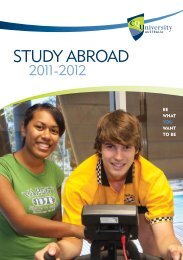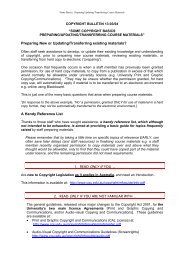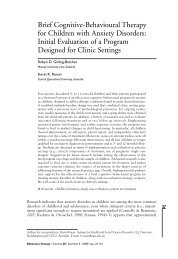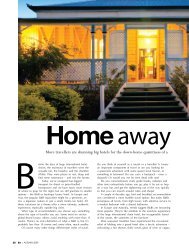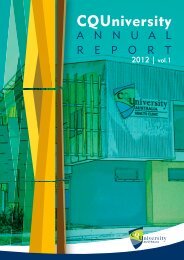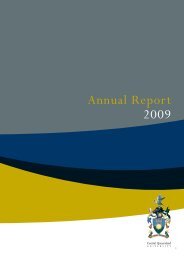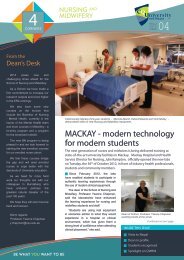4 Corners Newsletter - Vol 5 - Central Queensland University
4 Corners Newsletter - Vol 5 - Central Queensland University
4 Corners Newsletter - Vol 5 - Central Queensland University
You also want an ePaper? Increase the reach of your titles
YUMPU automatically turns print PDFs into web optimized ePapers that Google loves.
The ranger behind the<br />
mask<br />
Dr Kerry Reid Searl is a Professor and Sub Dean of<br />
Simulation in the School of Nursing and Midwifery<br />
at CQ<strong>University</strong>, but probably best renowned for her<br />
companions Iva Sore, Muriel Moore and Cyril Smith.<br />
Kerry grew up in Tasmania and went to art school studying<br />
Fine Arts before she ventured into Nursing. She did her hospital<br />
training as registered nurse in Hobart and her midwifery training<br />
in Townsville and gained extensive nursing experience in the<br />
Torres Strait and regional <strong>Queensland</strong>.<br />
When Kerry moved to Rockhampton, she did her masters<br />
degree in clinical education and PhD. She has been involved<br />
in undergraduate nursing for the past 22 years and remains a<br />
practicing clinician in the area of paediatrics.<br />
Whilst involved in teaching students in a clinical environment,<br />
Kerry was enticed by the idea of laboratory teaching where she<br />
was able to utilise her passion for creativity and drama and<br />
bringing it together in her teaching and learning.<br />
Role play was always part of her teaching and one of the<br />
challenges that she experienced was that if ‘in role’ students<br />
can still see her face - they could still detect the lecturer under<br />
the costume.<br />
“Whilst we had fun and engagement in the classroom, what was<br />
missing was the ability for students to really see me seriously as a<br />
patient and also to remove the teacher-student power imbalance.<br />
I then started looking for ways I could be hidden as the teacher.”<br />
At first, Kerry tried with solid masks, but it was only until she partnered with<br />
a Hollywood mask-maker to create realistic flexible silicon props (masks) that<br />
the idea really took off.<br />
“I was able to use the props in class to better engage the students and<br />
give them a true patient-nurse experience within the safety of the classroom<br />
before they enter the intimidating hospital environment,” Kerry said. Through<br />
her ‘masked’ character, she becomes a believable patient with an identity and<br />
complete medical history.<br />
Although Kerry created her first mask, out of paper mache, when she was 10<br />
years old, the first actual character she developed was Iva Sore.<br />
“Iva was a delightful lady in her senior years with a creative sense of humour.<br />
She would gather little treasures in her handbag giving students a reason to<br />
engage, but I wanted something more serious,” she explained. She wanted<br />
more serious characters that students could teach and learn through, and that’s<br />
when she came across her masks.<br />
After winning a teaching award, Kerry was able to purchase her first masks<br />
and while playing those characters she was able to see the students’ reactions<br />
and their engagement in the classroom.<br />
Encouraged by her twin sister’s remark that ‘she was doing far more than she<br />
realised’ she continued to develop the pedagogy that sat behind the technique.<br />
According to Kerry, the most important principle behind the technique is that<br />
the ‘hidden expert’ sits behind the plot. It is the ‘hidden expert’ that turns into a<br />
patient who has a history which allows them to be the platform for learning and<br />
teaching. “The character’s history has to be carefully constructed as they are in<br />
the learning space for a reason,“ she said.<br />
All the characters, each with a level of<br />
authenticity, must be able to verbalise<br />
what is going on. Through the technique,<br />
students are empowered – the characters<br />
develop a relationship with the students,<br />
always engaging them and helping them by<br />
sharing their knowledge and giving tips on<br />
how to do things.<br />
For example, one of her favourite<br />
characters, Cyril Smith, is a retired butcher<br />
and loves to talk about anatomy and<br />
physiology and what’s beneath the skin. He<br />
is also a first aid guru, so he is always on<br />
about priority care.<br />
Cyril has a grand-daughter doing<br />
nursing and who’s books he read<br />
and he’s been in and out of hospital<br />
himself so he draws on experiences<br />
and stories and reckons he<br />
knows enough to challenge the<br />
nursing students,” Kerry said.<br />
Students will meet Cyril Smith<br />
in their first year, first term and they<br />
will be involved with elements of his<br />
care throughout the curriculum. He<br />
also goes to their graduation dinner,<br />
dressed in a suit, to thank them and<br />
to congratulate them and saying how<br />
proud he is of what they’ve<br />
accomplished.<br />
6


